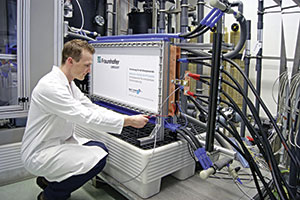
More and more electricity is being generated from intermittent sources of power, such as solar and wind energy. Powerful electric energy storage devices are necessary to level out corresponding irregularities in the power supply. Fraunhofer scientists have made a breakthrough with their development of a redox flow battery that reaches stack power up to 25 kW, with a cell size of 0.5 square meters. This is eight times larger than the previous A4-sized systems.
Almost a quarter of the electricity we use today is derived from renewable sources. Redox flow batteries offer an effective way to balance out fluctuations in the supply of renewable energy and thus guarantee its constant availability. The batteries store electrical energy in chemical compounds, the liquid electrolytes. The electrolytes are charged and discharged in small reaction chambers. Several of these cells are lined up in stacks. However, the batteries that are currently available on the market, which are roughly the size of A4 paper (1/16 square meters), can only generate 2.3 kilowatts (kW) of power.
Scientists at the Fraunhofer Institute for Environmental, Safety and Energy Technology UMSICHT in Oberhausen, Germany, have succeeded in increasing the size of the stack and its capacity. A new design has allowed them to produce stacks up to 0.5 square meters in size. This is eight times larger than the cells in previous systems and results in power up to 25 kW. The prototype has an efficiency of up to 80 percent, and can take a load of up to 500 amps of current.
So how have the experts managed to increase the size and capacity? Scientists began by testing new membrane materials and researching battery management and battery design. Flow simulations helped them to optimize the cell structure. A complete redesign of the battery followed that enabled the Fraunhofer team to make their breakthrough.
“Successfully redesigning the battery stacks was an important step in developing redox flow batteries that could, for example, supply 2,000 households with electricity,” said Dr. Christian Dötsch, division director Energy at Fraunhofer UMSICHT. This would require a capacity of around two megawatts, so the next fixed objective is to develop a stack that is two square meters in size and has a capacity of 100 kW.
The redox flow cell is an accumulator. It stores energy in electrolyte solutions contained in tanks. The electrolyte circulate from these tanks through a cell, which generates electricity from the fluid in a chemical process. The most common kind of this type of battery is the vanadium redox flow battery. The vanadium is charged and discharged in small reaction chambers. Several of these cells are lined up in stacks, which increases the battery’s power.







